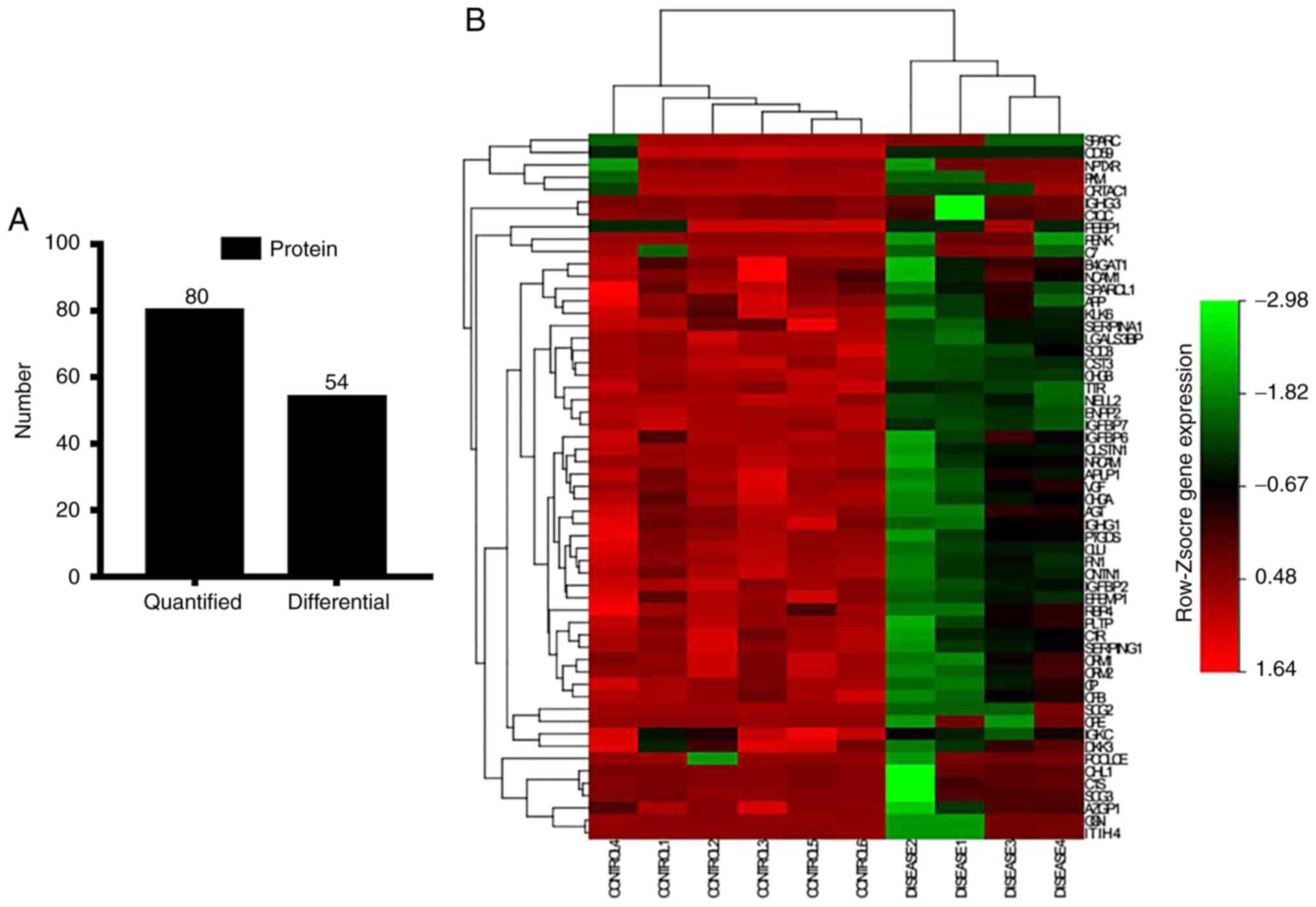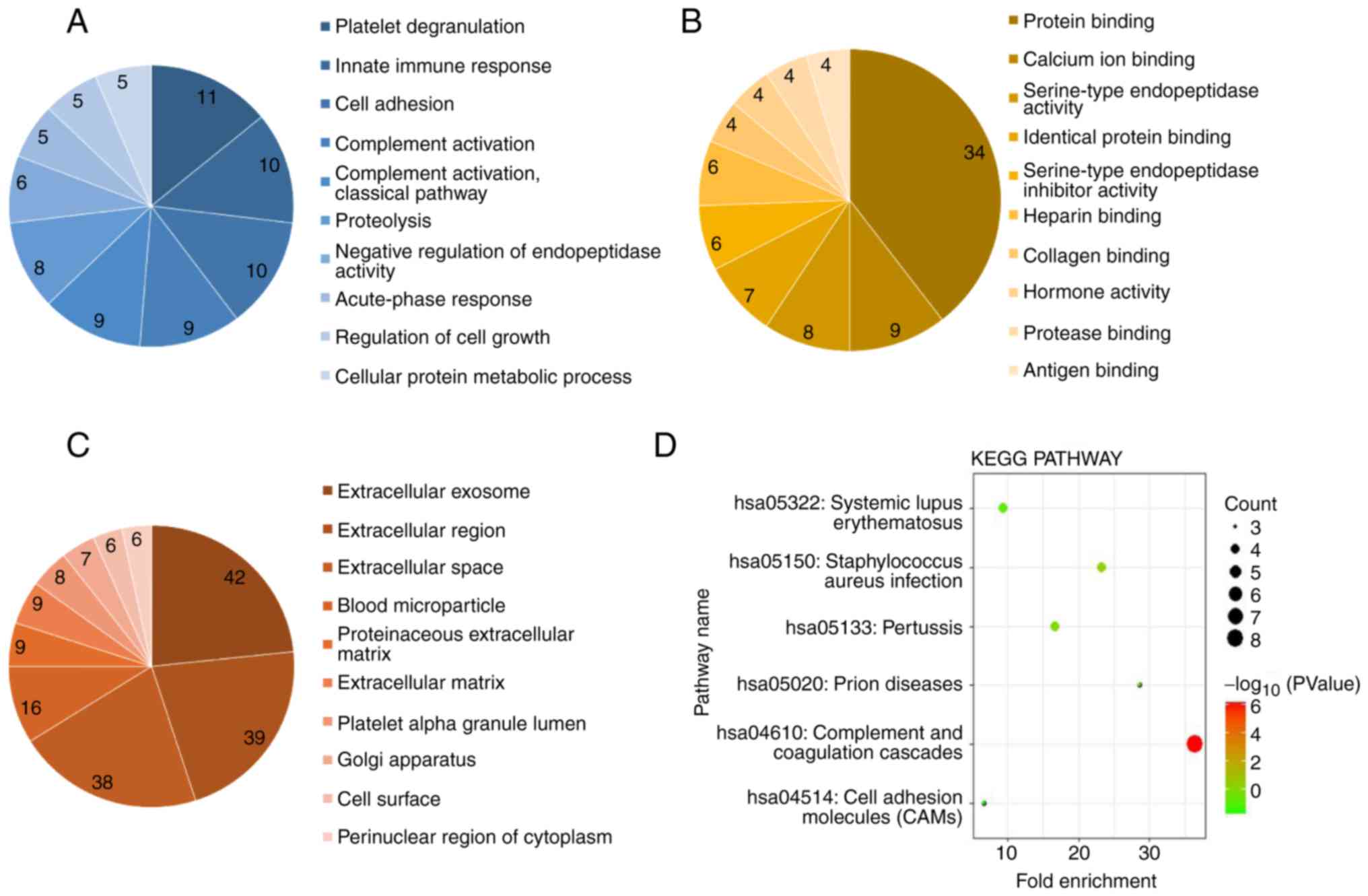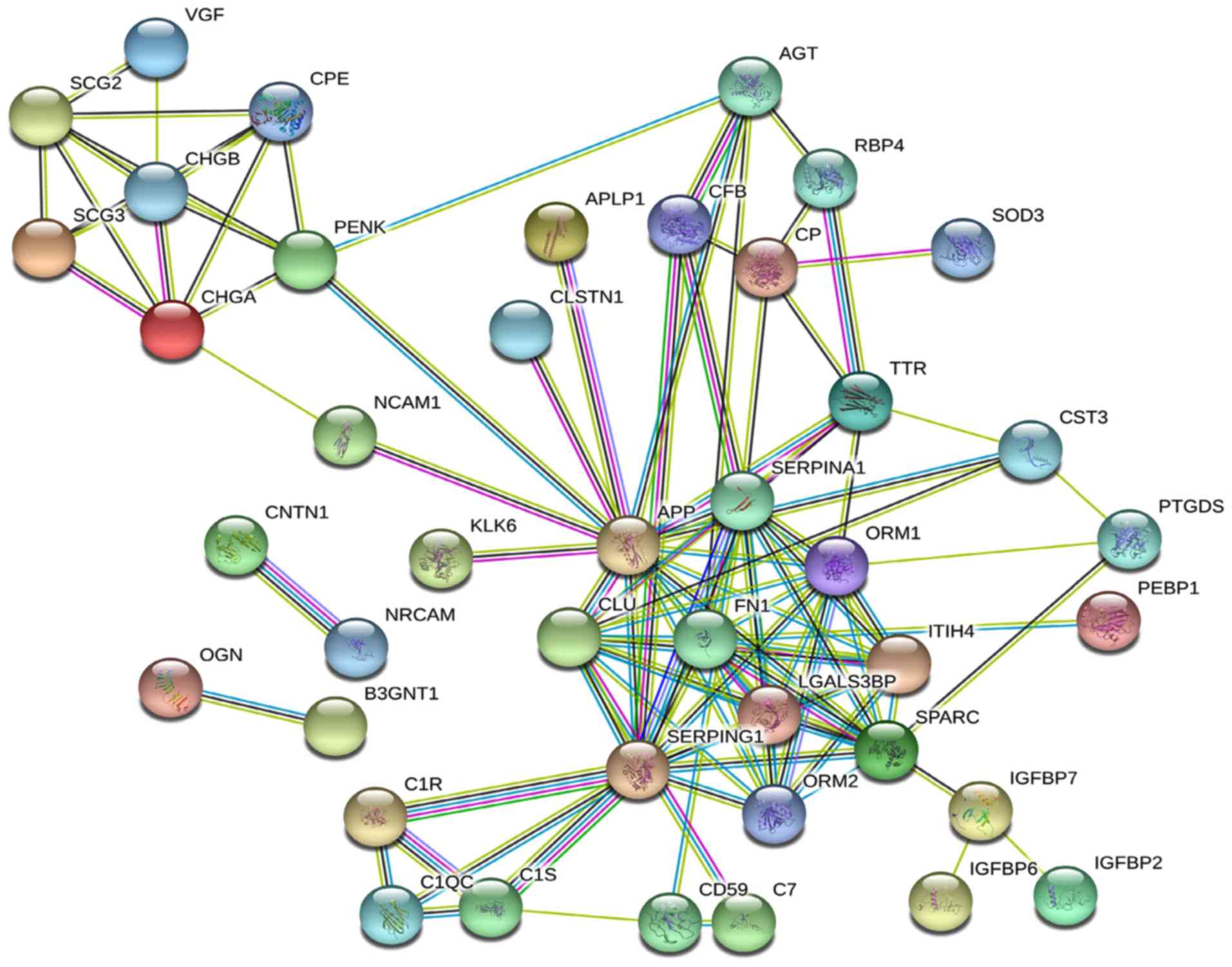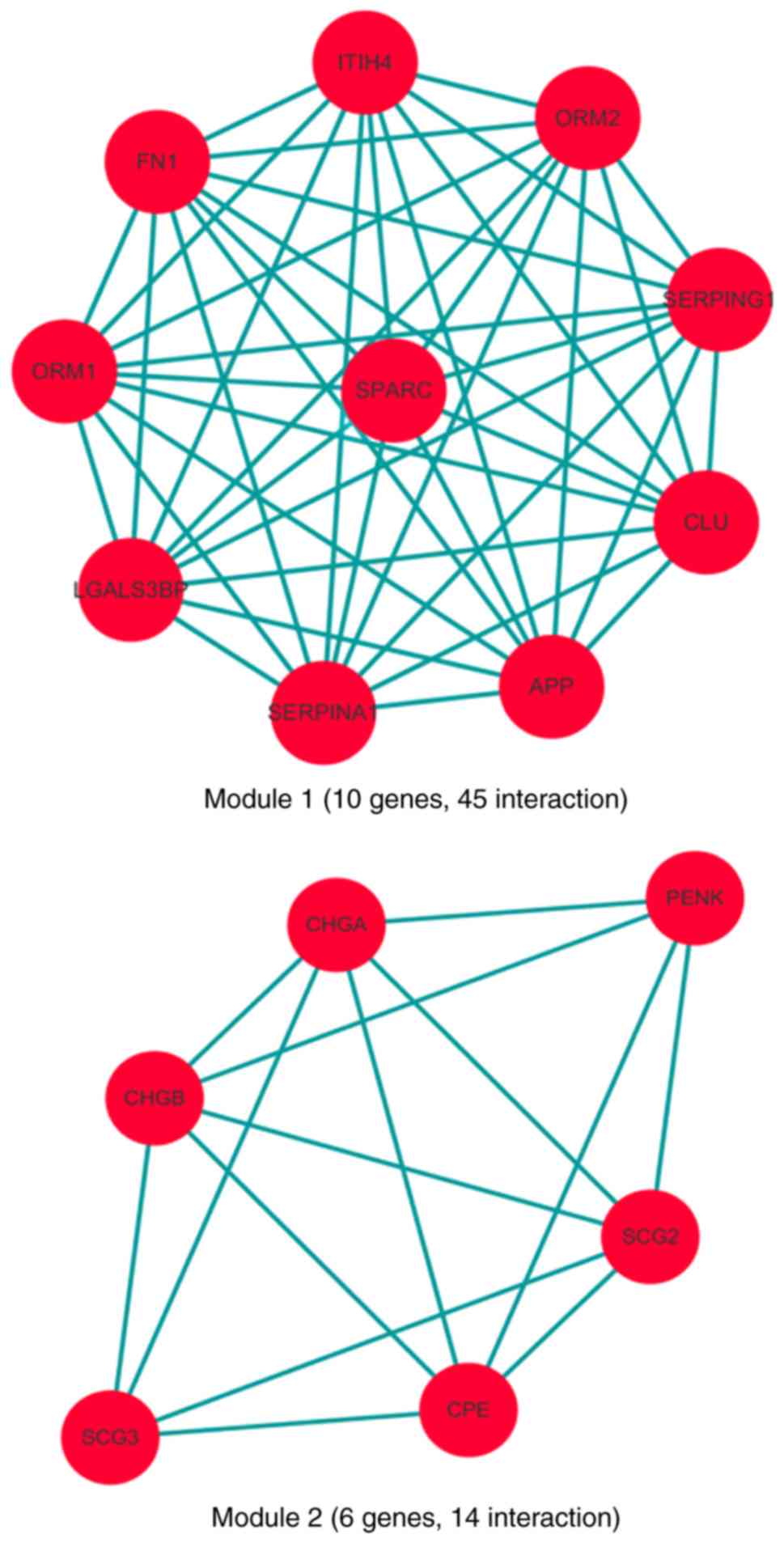|
1
|
A clinical evaluation of the International
Lymphoma Study Group classification of non-Hodgkin's lymphoma. The
Non-Hodgkin's Lymphoma Classification Project. Blood 89: 3909-3918,
1997.
|
|
2
|
Chen W, Wang H, Chen H, Liu S, Lu H, Kong
D, Huang X, Kong Q and Lu Z: Clinical significance and detection of
microRNA-21 in serum of patients with diffuse large B-cell lymphoma
in Chinese population. Eur J Haematol. 92:407–412. 2014.PubMed/NCBI View Article : Google Scholar
|
|
3
|
Martelli M, Ferreri AJ, Agostinelli C, Di
Rocco A, Pfreundschuh M and Pileri SA: Diffuse large B-cell
lymphoma. Crit Rev Oncol Hematol. 87:146–171. 2013.PubMed/NCBI View Article : Google Scholar
|
|
4
|
Feugier P, Van Hoof A, Sebban C,
Solal-Celigny P, Bouabdallah R, Fermé C, Christian B, Lepage E,
Tilly H, Morschhauser F, et al: Long-term results of the R-CHOP
study in the treatment of elderly patients with diffuse large
B-cell lymphoma: A study by the Groupe d'Etude des Lymphomes de
l'Adulte. J Clin Oncol. 23:4117–4126. 2005.PubMed/NCBI View Article : Google Scholar
|
|
5
|
Pfreundschuh M: Therapy of diffuse large
B-cell lymphomas. Eur J Cancer. 1 (Suppl 45):S386–S387. 2009.
|
|
6
|
Feugier P, Virion JM, Tilly H, Haioun C,
Marit G, Macro M, Bordessoule D, Recher C, Blanc M, Molina T, et
al: Incidence and risk factors for central nervous system
occurrence in elderly patients with diffuse large-B-cell lymphoma:
Influence of rituximab. Ann Oncol. 15:129–133. 2004.PubMed/NCBI View Article : Google Scholar
|
|
7
|
Herrlinger U, Glantz M, Schlegel U,
Gisselbrecht C and Cavalli F: Should intra-cerebrospinal fluid
prophylaxis be part of initial therapy for patients with
non-Hodgkin lymphoma: What we know, and how we can find out more.
Semin Oncol. 36 (4 Suppl 2):S25–S34. 2009.PubMed/NCBI View Article : Google Scholar
|
|
8
|
van Besien K, Ha CS, Murphy S, McLaughlin
P, Rodriguez A, Amin K, Forman A, Romaguera J, Hagemeister F,
Younes A, et al: Risk factors, treatment, and outcome of central
nervous system recurrence in adults with intermediate-grade and
immunoblastic lymphoma. Blood. 91:1178–1184. 1998.PubMed/NCBI
|
|
9
|
Zinzani PL, Magagnoli M, Frezza G, Prologo
G, Gherlinzoni F, Bendandi M, Albertini P, Babini L, D'Alessandro R
and Tura S: Isolated central nervous system relapse in aggressive
non-Hodgkin's lymphoma: The Bologna experience. Leuk Lymphoma.
32:571–576. 1999.PubMed/NCBI View Article : Google Scholar
|
|
10
|
Hollender A, Kvaloy S, Nome O, Skovlund E,
Lote K and Holte H: Central nervous system involvement following
diagnosis of non-Hodgkin's lymphoma: A risk model. Ann Oncol.
13:1099–1107. 2002.PubMed/NCBI View Article : Google Scholar
|
|
11
|
Zahid MF, Khan N, Hashmi SK, Kizilbash SH
and Barta SK: Central nervous system prophylaxis in diffuse large
B-cell lymphoma. Eur J Haematol. 97:108–120. 2016.PubMed/NCBI View Article : Google Scholar
|
|
12
|
Haioun C, Besson C, Lepage E, Thieblemont
C, Simon D, Rose C, Tilly H, Sonet A, Lederlin P, Attal M, et al:
Incidence and risk factors of central nervous system relapse in
histologically aggressive non-Hodgkin's lymphoma uniformly treated
and receiving intrathecal central nervous system prophylaxis: A
GELA study on 974 patients. Groupe d'Etudes des Lymphomes de
l'Adulte. Ann Oncol. 11:685–690. 2000.PubMed/NCBI View Article : Google Scholar
|
|
13
|
Barosi G, Carella A, Lazzarino M,
Marchetti M, Martelli M, Rambaldi A, Tarella C, Vitolo U, Zinzani
PL, Tura S, et al: Management of nodal diffuse large B-cell
lymphomas: Practice guidelines from the italian society of
hematology, the italian society of experimental hematology and the
italian group for bone marrow transplantation. Haematologica.
91:96–103. 2006.PubMed/NCBI
|
|
14
|
Boehme V, Zeynalova S, Kloess M, Loeffler
M, Kaiser U, Pfreundschuh M and Schmitz N: German High-Grade
Non-Hodgkin's Lymphoma Study Group (DSHNHL): Incidence and risk
factors of central nervous system recurrence in aggressive
lymphoma-a survey of 1693 patients treated in protocols of the
German High-Grade Non-Hodgkin's Lymphoma Study Group (DSHNHL). Ann
Oncol. 18:149–157. 2007.PubMed/NCBI View Article : Google Scholar
|
|
15
|
Hill QA and Owen RG: CNS prophylaxis in
lymphoma: Who to target and what therapy to use. Blood Rev.
20:319–332. 2006.PubMed/NCBI View Article : Google Scholar
|
|
16
|
Liang R, Chiu E and Loke SL: Secondary
central nervous system involvement by non-Hodgkin's lymphoma: The
risk factors. Hematol Oncol. 8:141–145. 1990.PubMed/NCBI
|
|
17
|
Fletcher CD and Kahl BS: Central nervous
system involvement in diffuse large B-cell lymphoma: An analysis of
risks and prevention strategies in the post-rituximab era. Leuk
Lymphoma. 55:2228–2240. 2014.PubMed/NCBI View Article : Google Scholar
|
|
18
|
Holte H, Leppä S, Björkholm M, Fluge O,
Jyrkkiö S, Delabie J, Sundström C, Karjalainen-Lindsberg ML,
Erlanson M, Kolstad A, et al: Dose-densified chemoimmunotherapy
followed by systemic central nervous system prophylaxis for younger
high-risk diffuse large B-cell/follicular grade 3 lymphoma
patients: Results of a phase II Nordic Lymphoma Group study. Ann
Oncol. 24:1385–1392. 2013.PubMed/NCBI View Article : Google Scholar
|
|
19
|
Penalver FJ, Sancho JM, de la Fuente A,
Olave MT, Martín A, Panizo C, Pérez E, Salar A and Orfao A: Spanish
Lymphoma Group (GELTAMO): Guidelines for diagnosis, prevention and
management of central nervous system involvement in diffuse large
B-cell lymphoma patients by the Spanish Lymphoma Group (GELTAMO).
Haematologica. 102:235–245. 2017.PubMed/NCBI View Article : Google Scholar
|
|
20
|
Glass JP, Melamed M, Chernik NL and Posner
JB: Malignant cells in cerebrospinal fluid (CSF): The meaning of a
positive CSF cytology. Neurology. 29:1369–1375. 1979.PubMed/NCBI View Article : Google Scholar
|
|
21
|
Hegde U, Filie A, Little RF, Janik JE,
Grant N, Steinberg SM, Dunleavy K, Jaffe ES, Abati A,
Stetler-Stevenson M and Wilson WH: High incidence of occult
leptomeningeal disease detected by flow cytometry in newly
diagnosed aggressive B-cell lymphomas at risk for central nervous
system involvement: The role of flow cytometry versus cytology.
Blood. 105:496–502. 2005.PubMed/NCBI View Article : Google Scholar
|
|
22
|
McMillan A, Ardeshna KM, Cwynarski K,
Lyttelton M, McKay P and Montoto S: British Committee for Standards
in Haematology: Guideline on the prevention of secondary central
nervous system lymphoma: British committee for standards in
haematology. Br J Haematol. 163:168–181. 2013.PubMed/NCBI View Article : Google Scholar
|
|
23
|
Villa D, Connors JM, Shenkier TN, Gascoyne
RD, Sehn LH and Savage KJ: Incidence and risk factors for central
nervous system relapse in patients with diffuse large B-cell
lymphoma: The impact of the addition of rituximab to CHOP
chemotherapy. Ann Oncol. 21:1046–1052. 2010.PubMed/NCBI View Article : Google Scholar
|
|
24
|
Shimazu Y, Notohara K and Ueda Y: Diffuse
large B-cell lymphoma with central nervous system relapse:
Prognosis and risk factors according to retrospective analysis from
a single-center experience. Int J Hematol. 89:577–583.
2009.PubMed/NCBI View Article : Google Scholar
|
|
25
|
Scott BJ, Douglas VC, Tihan T, Rubenstein
JL and Josephson SA: A systematic approach to the diagnosis of
suspected central nervous system lymphoma. JAMA Neurol. 70:311–319.
2013.PubMed/NCBI View Article : Google Scholar
|
|
26
|
Shen X, Young R, Canty JM and Qu J:
Quantitative proteomics in cardiovascular research: Global and
targeted strategies. Proteomics Clin Appl. 8:488–505.
2014.PubMed/NCBI View Article : Google Scholar
|
|
27
|
Weisser H, Nahnsen S, Grossmann J, Nilse
L, Quandt A, Brauer H, Sturm M, Kenar E, Kohlbacher O, Aebersold R
and Malmström L: An automated pipeline for high-throughput
label-free quantitative proteomics. J Proteome Res. 12:1628–1644.
2013.PubMed/NCBI View Article : Google Scholar
|
|
28
|
Gitau EN, Kokwaro GO, Karanja H, Newton CR
and Ward SA: Plasma and cerebrospinal proteomes from children with
cerebral malaria differ from those of children with other
encephalopathies. J Infect Dis. 208:1494–1503. 2013. View Article : Google Scholar
|
|
29
|
Ou Q, Liu X and Cheng X: An iTRAQ approach
to quantitative proteome analysis of cerebrospinal fluid from
patients with tuberculous meningitis. Biosci Trends. 7:186–192.
2013.PubMed/NCBI View Article : Google Scholar
|
|
30
|
Pasinetti GM, Ungar LH, Lange DJ, Yemul S,
Deng H, Yuan X, Brown RH, Cudkowicz ME, Newhall K, Peskind E, et
al: Identification of potential CSF biomarkers in ALS. Neurology.
66:1218–1222. 2006.PubMed/NCBI View Article : Google Scholar
|
|
31
|
Priola GM, Foster MW, Deal AM, Richardson
BM, Thompson JW and Blatt J: Cerebrospinal fluid proteomics in
children during induction for acute lymphoblastic leukemia: A pilot
study. Pediatr Blood Cancer. 62:1190–1194. 2015.PubMed/NCBI View Article : Google Scholar
|
|
32
|
Rardin MJ, Newman JC, Held JM, Cusack MP,
Sorensen DJ, Li B, Schilling B, Mooney SD, Kahn CR, Verdin E and
Gibson BW: Label-free quantitative proteomics of the lysine
acetylome in mitochondria identifies substrates of SIRT3 in
metabolic pathways. Proc Natl Acad Sci USA. 110:6601–6606.
2013.PubMed/NCBI View Article : Google Scholar
|
|
33
|
Chlenski A and Cohn SL: Modulation of
matrix remodeling by SPARC in neoplastic progression. Semin Cell
Dev Biol. 21:55–65. 2010.PubMed/NCBI View Article : Google Scholar
|
|
34
|
Bradshaw AD, Puolakkainen P, Dasgupta J,
Davidson JM, Wight TN and Helene Sage E: SPARC-null mice display
abnormalities in the dermis characterized by decreased collagen
fibril diameter and reduced tensile strength. J Invest Dermatol.
120:949–955. 2003.PubMed/NCBI View Article : Google Scholar
|
|
35
|
Raines EW, Lane TF, Iruela-Arispe ML, Ross
R and Sage EH: The extracellular glycoprotein SPARC interacts with
platelet-derived growth factor (PDGF)-AB and -BB and inhibits the
binding of PDGF to its receptors. Proc Natl Acad Sci USA.
89:1281–1285. 1992.PubMed/NCBI View Article : Google Scholar
|
|
36
|
Sangaletti S, Stoppacciaro A, Guiducci C,
Torrisi MR and Colombo MP: Leukocyte, rather than tumor-produced
SPARC, determines stroma and collagen type IV deposition in mammary
carcinoma. J Exp Med. 198:1475–1485. 2003.PubMed/NCBI View Article : Google Scholar
|
|
37
|
Weaver MS, Workman G and Sage EH: The
copper binding domain of SPARC mediates cell survival in vitro via
interaction with integrin beta1 and activation of integrin-linked
kinase. J Biol Chem. 283:22826–22837. 2008.PubMed/NCBI View Article : Google Scholar
|
|
38
|
Tai IT and Tang MJ: SPARC in cancer
biology: Its role in cancer progression and potential for therapy.
Drug Resist Updat. 11:231–246. 2008.PubMed/NCBI View Article : Google Scholar
|
|
39
|
Bhoopathi P, Chetty C, Gujrati M, Dinh DH,
Rao JS and Lakka S: Cathepsin B facilitates autophagy-mediated
apoptosis in SPARC overexpressed primitive neuroectodermal tumor
cells. Cell Death Differ. 17:1529–1539. 2010.PubMed/NCBI View Article : Google Scholar
|
|
40
|
Meyer PN, Fu K, Greiner T, Smith L,
Delabie J, Gascoyne R, Ott G, Rosenwald A, Braziel R, Campo E, et
al: The stromal cell marker SPARC predicts for survival in patients
with diffuse large B-cell lymphoma treated with rituximab. Am J
Clin Pathol. 135:54–61. 2011. View Article : Google Scholar
|
|
41
|
Bottger A and Spruce BA: Proenkephalin is
a nuclear protein responsive to growth arrest and differentiation
signals. J Cell Biol. 130:1251–1262. 1995.PubMed/NCBI View Article : Google Scholar
|
|
42
|
Sonnenberg JL, Rauscher FJ III, Morgan JI
and Curran T: Regulation of proenkephalin by Fos and Jun. Science.
246:1622–1625. 1989.PubMed/NCBI View Article : Google Scholar
|
|
43
|
Ueki T, Toyota M, Skinner H, Walter KM,
Yeo CJ, Issa JP, Hruban RH and Goggins M: Identification and
characterization of differentially methylated CpG islands in
pancreatic carcinoma. Cancer Res. 61:8540–8546. 2001.PubMed/NCBI
|
|
44
|
Fukushima N, Sato N, Ueki T, Rosty C,
Walter KM, Wilentz RE, Yeo CJ, Hruban RH and Goggins M: Aberrant
methylation of preproenkephalin and p16 genes in pancreatic
intraepithelial neoplasia and pancreatic ductal adenocarcinoma. Am
J Pathol. 160:1573–1581. 2002.PubMed/NCBI View Article : Google Scholar
|
|
45
|
Goo YA, Goodlett DR, Pascal LE,
Worthington KD, Vessella RL, True LD and Liu AY: Stromal mesenchyme
cell genes of the human prostate and bladder. BMC Urol.
5(17)2005.PubMed/NCBI View Article : Google Scholar
|
|
46
|
Tan AC, Jimeno A, Lin SH, Wheelhouse J,
Chan F, Solomon A, Rajeshkumar NV, Rubio-Viqueira B and Hidalgo M:
Characterizing DNA methylation patterns in pancreatic cancer
genome. Mol Oncol. 3:425–438. 2009.PubMed/NCBI View Article : Google Scholar
|
|
47
|
Roperch JP, Incitti R, Forbin S, Bard F,
Mansour H, Mesli F, Baumgaertner I, Brunetti F and Sobhani I:
Aberrant methylation of NPY, PENK, and WIF1 as a promising marker
for blood-based diagnosis of colorectal cancer. BMC Cancer.
13(566)2013.PubMed/NCBI View Article : Google Scholar
|
|
48
|
Lee EJ, Rath P, Liu J, Ryu D, Pei L,
Noonepalle SK, Shull AY, Feng Q, Litofsky NS, Miller DC, et al:
Identification of global DNA methylation signatures in
glioblastoma-derived cancer stem cells. J Genet Genomics.
42:355–371. 2015.PubMed/NCBI View Article : Google Scholar
|


















